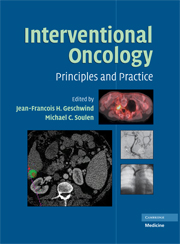Book contents
- Frontmatter
- Contents
- FOREWORD
- ACKNOWLEDGMENTS
- CONTRIBUTORS
- PART I PRINCIPLES OF ONCOLOGY
- PART II PRINCIPLES OF IMAGE-GUIDED THERAPIES
- 5 Image-guided Interventions: Fundamentals of Radiofrequency Tumor Ablation
- 6 Principles of Embolization
- 7 Imaging in Interventional Oncology: Role of Image Guidance
- 8 Assessment of Tumor Response on Magnetic Resonance Imaging after Locoregional Therapy
- PART III ORGAN-SPECIFIC CANCERS
- PART IV SPECIALIZED INTERVENTIONAL TECHNIQUES IN CANCER CARE
- INDEX
- Plate section
- References
8 - Assessment of Tumor Response on Magnetic Resonance Imaging after Locoregional Therapy
from PART II - PRINCIPLES OF IMAGE-GUIDED THERAPIES
Published online by Cambridge University Press: 18 May 2010
- Frontmatter
- Contents
- FOREWORD
- ACKNOWLEDGMENTS
- CONTRIBUTORS
- PART I PRINCIPLES OF ONCOLOGY
- PART II PRINCIPLES OF IMAGE-GUIDED THERAPIES
- 5 Image-guided Interventions: Fundamentals of Radiofrequency Tumor Ablation
- 6 Principles of Embolization
- 7 Imaging in Interventional Oncology: Role of Image Guidance
- 8 Assessment of Tumor Response on Magnetic Resonance Imaging after Locoregional Therapy
- PART III ORGAN-SPECIFIC CANCERS
- PART IV SPECIALIZED INTERVENTIONAL TECHNIQUES IN CANCER CARE
- INDEX
- Plate section
- References
Summary
Assessment of tumor response after locoregional therapy is important in determining treatment success and in guiding future therapy. Magnetic resonance (MR) imaging plays an important role in evaluating treatment response to new therapies directed toward treatment of hepatic tumors. The traditional and accepted criteria to determine tumor response in oncology, namely the Response Evaluation Criteria in Solid Tumors (RECIST), use decrease in tumor size as an indicator of successful therapy. However, because of the lack of size change early after treatment, the European Association for the Study of the Liver (EASL) criteria were introduced and are based on lack of contrast enhancement after therapy as an indicator of favorable response. A more recent evaluation method is the apparent diffusion coefficient (ADC), measured by diffusion-weighted MR imaging. Diffusion-weighted MR imaging and ADC values map the thermally induced motion of water molecules in tissues and thereby are able to provide insight into tumor microstructure. In this chapter, we discuss the role of MR imaging in assessing treatment response after various locoregional therapies. We describe the role of tumor size (as recommended by RECIST) and enhancement (as suggested by EASL) as well as ADC mapping. We also discuss the MR imaging findings after radiofrequency ablation (RFA), transarterial chemoembolization (TACE) and radioembolization.
Although surgical resection and liver transplantation offer the only chance for cure in patients with hepatic malignancies, unfortunately, tumors in most patients are found to be unresectable at time of presentation, leaving palliative therapy as the only option.
- Type
- Chapter
- Information
- Interventional OncologyPrinciples and Practice, pp. 86 - 98Publisher: Cambridge University PressPrint publication year: 2008



